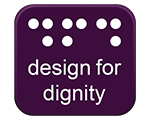Guidance on customer service
Vision
Around 357,000 people in Australia are blind or have a vision impairment that cannot be corrected by glasses. Most of these customers have some vision, but it may be cloudy, distorted or blurred. Only a very small percentage of people who are considered legally blind have no vision at all.
People who are blind or have low vision may use a cane or a guide dog to help them to navigate and may also use “Assistive Technology” to access information.
Ways you can help
- Introduce yourself and your role when you approach and ask how you may help.
- A person with a guide dog may want their guide dog to follow you. If that's the case, walk normally.
- If the customer wants you to guide them, offer them your elbow for them to hold onto. Don't take their arm.
- Describe the layout of the area for the customer, particularly any obstacles such as stairs or displays. Be specific. ie. “The desk is one metre in front of you.”
- Check the customer has taken all their possessions with them when they leave.
- You may need to read out small print to the customer.
- Make sure the signage for entries, exits and toilets is clear and illuminated where possible.
Avoid:
- Assuming that the customer may need your help.
- Patting a guide dog or other assistance animal, or distracting it with food.
- Walking away without letting the customer know you're leaving.
- Crossing the customer's path of travel — they might not be able to see where you are going.



